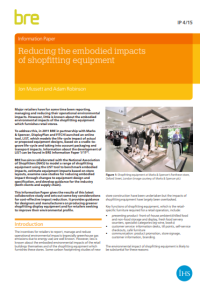Reducing the embodied impacts of shopfitting equipment
BRE is an independent, research-based consultancy, testing and training organisation, operating in the built environment and associated industries.
Reducing the embodied impacts of shopfitting equipment (IP 4/15) was written by Jon Mussett and Adam Robinson and published by BRE on 5 February 2015.
Major retailers have been reporting, managing and reducing their operational environmental impacts for some time. However, little is known about the embodied environmental impacts of shopfitting equipment.
Key functions of shopfitting equipment include:
- Presenting product: front-of-hose ambient/chilled food and non-food storage and display, fresh food servery counters and specialist categories (such as wine and books).
- Customer service: information desks, till points, self-service checkouts and café furniture.
- Communication: product promotion, store signage, customer information and branding.
In 2011, BRE in partnership with Marks & Spencer, DisplayPlan and FITCH, launched LIST, an online tool that models the impact of equipment designs, based on a cradle-to-grave life-cycle and taking into account packaging and transport impacts.
BRE has since collaborated with the National Association of Shopfitters (NAS) to model a range of shopfitting equipment using the LIST tool to benchmark embodied impacts, estimate equipment impacts, examine case studies for reducing embodied impact through changes to equipment design and specification, and develop guidance for the industry.
This 8-page information paper gives the results of this collaborative study and sets out key considerations for cost-effective impact reduction. It provides guidance for designers and manufacturers on producing greener shopfitting display equipment and for retailers seeking to improve their environmental profile.
Its contents are:
- Introduction.
- Embodied impacts of items of shopfitting equipment.
- Estimating equipment impacts for the retail sector.
- Case study using a Marks & Spencer merchandising frame.
- Guidance for the retail industry.
- Conclusions.
- References.
[edit] Find out more.
[edit] Related articles on Designing Buildings Wiki
- BRE articles on Designing Buildings Wiki.
- BRE Buzz articles on Designing Buildings Wiki.
- BRE Buzz.
- BREEAM and retail
- BREEAM puts the emphasis on green retail
- BREEAM.
- Building Research Establishment.
- Cheshire Oaks: Marks and Spencer
- Life cycle assessment.
- The essential guide to retail lighting
- The impact of lighting in retail design
Featured articles and news
RTPI leader to become new CIOB Chief Executive Officer
Dr Victoria Hills MRTPI, FICE to take over after Caroline Gumble’s departure.
Social and affordable housing, a long term plan for delivery
The “Delivering a Decade of Renewal for Social and Affordable Housing” strategy sets out future path.
A change to adoptive architecture
Effects of global weather warming on architectural detailing, material choice and human interaction.
The proposed publicly owned and backed subsidiary of Homes England, to facilitate new homes.
How big is the problem and what can we do to mitigate the effects?
Overheating guidance and tools for building designers
A number of cool guides to help with the heat.
The UK's Modern Industrial Strategy: A 10 year plan
Previous consultation criticism, current key elements and general support with some persisting reservations.
Building Safety Regulator reforms
New roles, new staff and a new fast track service pave the way for a single construction regulator.
Architectural Technologist CPDs and Communications
CIAT CPD… and how you can do it!
Cooling centres and cool spaces
Managing extreme heat in cities by directing the public to places for heat stress relief and water sources.
Winter gardens: A brief history and warm variations
Extending the season with glass in different forms and terms.
Restoring Great Yarmouth's Winter Gardens
Transforming one of the least sustainable constructions imaginable.
Construction Skills Mission Board launch sector drive
Newly formed government and industry collaboration set strategy for recruiting an additional 100,000 construction workers a year.
New Architects Code comes into effect in September 2025
ARB Architects Code of Conduct and Practice available with ongoing consultation regarding guidance.
Welsh Skills Body (Medr) launches ambitious plan
The new skills body brings together funding and regulation of tertiary education and research for the devolved nation.
Paul Gandy FCIOB announced as next CIOB President
Former Tilbury Douglas CEO takes helm.
UK Infrastructure: A 10 Year Strategy. In brief with reactions
With the National Infrastructure and Service Transformation Authority (NISTA).
























